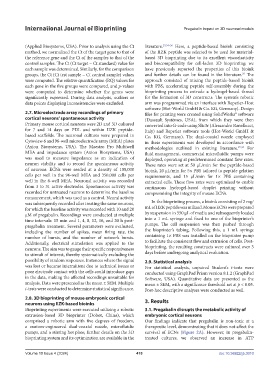Page 418 - IJB-10-4
P. 418
International Journal of Bioprinting Pregabalin impact on 3D neuronal models
(Applied Biosystems, USA). Prior to analysis using the Ct literature. 29,34–36 Here, a peptide-based bioink consisting
method, we normalized the Ct of the target gene to that of of the IIZK peptide was selected to be used for material-
the reference gene and the Ct of the samples to that of the based 3D bioprinting due to its excellent viscoelasticity
control samples. The Ct (Ct target − Ct standard) value for and biocompatibility for cell-laden 3D bioprinting; we
each sample was determined. Similarly, for the comparison have previously reported the properties of this bioink
groups, the Ct (Ct test sample − Ct control sample) values and further details can be found in the literature. The
29
were computed. The relative quantification (RQ) values for approach consisted of mixing the peptide-based bioink
each gene in the five groups were compared, and p-values with PBS, accelerating peptide self-assembly during the
were computed to determine whether the genes were bioprinting process to extrude a hydrogel-based thread
significantly expressed. During data analysis, outliers or for the formation of 3D constructs. The system’s robotic
data points displaying inconsistencies were excluded. arm was programmed via an interface with Repetier-Host
software (Hot-World GmbH & Co. KG, Germany). Design
2.7. Microelectrode array recordings of primary files for printing were created using SolidWorks® software
cortical neurons’ spontaneous activity (Dassault Systèmes, USA), from which they were then
Primary mouse cortical neurons were 2D and 3D cultured converted into G-code using Slic3r (Alessandro Ranellucci,
for 7 and 14 days on PDL and within IIZK peptide- Italy) and Repetier software tools (Hot-World GmbH &
based scaffolds. The neuronal cultures were prepared in Co. KG, Germany). The dual-coaxial nozzle employed
Cytoview 6 and 96-well microelectrode array (MEA) plates in these experiments was developed in accordance with
(Axion Biosystems, USA). The Maestro Pro Multiwell methodologies outlined in existing literature. 29,35 For
MEA and impedance system (Axion Biosystems, USA) fluid management, commercial microfluidic pumps were
was used to measure impedance as an indication of deployed, operating at predetermined constant flow rates.
neuron viability and to record the spontaneous activity These rates were set at 50 μL/min for the peptide-based
of neurons. ECNs were seeded at a density of 100,000 bioink, 20 μL/min for 5× PBS tailored to peptide gelation
cells per well in the 96-well MEA and 350,000 cells per requirements, and 15 μL/min for 1× PBS containing
well in the 6-well MEA. Neuronal activity was recorded extracted cells. These flow rates were optimized to enable
from 3 to 31 active electrodes. Spontaneous activity was continuous hydrogel-based droplet printing without
recorded for untreated neurons to determine the baseline compromising the integrity of mouse ECNs.
measurement, which was used as a control. Neural activity
was subsequently recorded after treating the same neurons, In the bioprinting process, a bioink consisting of 2 mg/
for which the baseline activity was recorded with 10 and 20 mL of IIZK peptide was utilized. Mouse ECNs were prepared
µM of pregabalin. Recordings were conducted at multiple by suspension in 550 μL of media and subsequently loaded
time intervals: 15 min and 1, 4, 8, 12, 16, and 20 h post- into a 1 mL syringe and fixed to one of the bioprinter’s
pregabalin treatment. Several parameters were evaluated, pumps. The cell suspension was then pushed through
including the number of spikes, mean firing rate, the the bioprinter’s tubing. Following this, a 1 mL syringe
number of bursts, and the number of network bursts. containing 1× PBS was installed on the bioprinter pump
Additionally, electrical stimulation was applied to the to facilitate the consistent flow and extrusion of cells. Post-
neurons. The aim was to gauge their specific responsiveness bioprinting, the resulting constructs were cultured over 3
to stimuli of interest, thereby systematically excluding the days before undergoing analytical evaluation.
possibility of random responses. Instances where the signal 2.9. Statistical analysis
was lost or became intermittent due to technical issues or For statistical analysis, unpaired Student’s t-tests were
poor electrode contact with the cells could introduce gaps conducted using GraphPad Prism version 8.1.2 (GraphPad
in the data, making the affected recordings unsuitable for Software, USA). Quantitative data are presented as the
analysis. Data were presented as the mean ± SEM. Multiple mean ± SEM, with a significance threshold set at p < 0.05.
t-tests were conducted to determine statistical significance. Post-hoc descriptive analyses were conducted as well.
2.8. 3D bioprinting of mouse embryonic cortical 3. Results
neurons using IIZK-based bioinks
Bioprinting experiments were executed utilizing a robotic 3.1. Pregabalin disrupts the metabolic activity of
extrusion-based 3D bioprinter (Dobot, China), which embryonic cortical neurons
comprised a robotic arm with five degrees of freedom, Our findings indicate that pregabalin is non-toxic at a
a custom-engineered dual-coaxial nozzle, microfluidic therapeutic level, demonstrating that it does not affect the
pumps, and a stirring hot plate; further details on the 3D survival of ECNs (Figure 2A). However, in pregabalin-
bioprinting system and its optimization are available in the treated cultures, we observed an increase in ATP
Volume 10 Issue 4 (2024) 410 doi: 10.36922/ijb.3010

